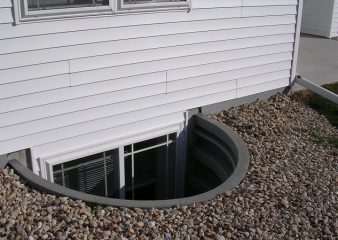What is a window well?
Let’s start with the basics. A window well is a U-shaped, ribbed metal or plastic product available in most home hardware stores. It’s designed to fit around basement windows, providing a space between the window and the surrounding earth to allow light into sub-grade structures. In some cases, window wells also provide an emergency point of egress. But, some homeowners aren’t aware that properly installed window wells also play an important role in draining excess rainwater away from your foundation. But, how do they work?
When installing a window well, the first step is to excavate the earth surrounding the window. Usually, this hole is dug to a depth of around 1 foot beneath the bottom of the window sill. Before the window well itself is installed, it’s important to consider drainage. After all, left alone, a giant hole at the side of your home is bound to collect water.
To avoid this, homeowners have several options. The well is usually partially filled with gravel, and sometimes a drain that connects to your perimeter drain is installed. This added safety measure will ensure that water can’t gather in your well and exert force on the windows, causing them to crack or leak.
If your window wells don’t already feature a drainage system, we recommend contacting a professional for installation, as, in some cases, the process can involve making alterations to your foundation. A contractor will also be able to advise on the best type of drainage system for your property:
Exterior drains sit in the gravel pit at the bottom of your window well. They extend to the base of your foundation and are connected to your perimeter drain (or weeping tile).
Interior drains redirect rainwater to your sump pump. Water is then moved away from the property through a network of pipes. As sump pumps are located inside the property, this method requires cutting a hole in your foundation wall to connect the sump pump to the window well.
For more information on both types of drain, check out Basement Technologies’ step-by-step guide. Once drainage has been taken care of, the plastic or steel window well is placed in the hole to prevent the earth from falling back in. The remaining space surrounding the window well is filled with dirt which should be compacted and graded so that water drains away from, not towards, the window.
The City of Edmonton provided a useful guide for homeowners that includes tips on preventing water damage from window wells. They advise homeowners to ensure that the outer edges of their window wells sit tight and flush against the basement wall in order to prevent leaks. Click here to take a look at the guide in full.
Maintaining your window wells
The primary concern for maintaining window wells relates to debris (most often leaves and other organic matter) that falls into the well, clogging the drainage system. This can result in a back up of water, which exerts pressure against the glass. This can have a variety of adverse effects, ranging from water seeping through porous concrete, leaving damp on the inside of your walls, to broken windows and interior water damage. So, what should you do to maintain your window wells?
The simplest and most effective measure is to periodically clear the debris from your window wells. We recommend doing this twice a year; once in fall and once in spring. When this is done, ensure that any drainage pipes that are part of your system are also not clogged. It’s also important that the gravel in your window well is loose. This will allow water to effectively drain to the perimeter drain. If the gravel becomes compacted, or if it’s improperly installed with sand, its efficacy is compromised.
Homeowners interested in preventative maintenance should consider a window well cover. While various types are available (mesh, plastic bubble covers, grill-type, etc.), their purpose remains simple; prevent debris from entering the window well by providing a physical barrier between the well and the elements. Most covers are designed to still permit light to enter your basement, too.
Once your window well is installed, adding a cover is quick and easy, and something most homeowners will be able to do themselves.


